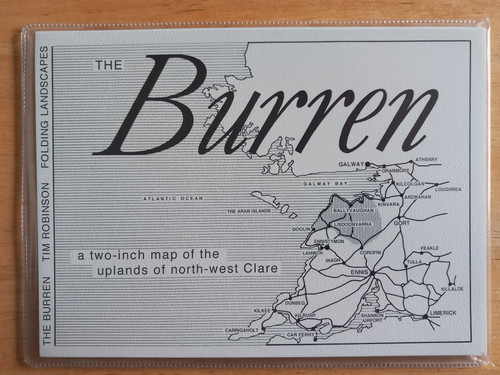Product Description
Folded map in clear plastic cover, APPROx A5 size , published by Folding Landscapes, Roundstone, Conamara .
The Burren, a two-inch map of the uplands of north-west Clare. Shows the scarped limestone topography, National Park, roads and paths, caves and potholes, inset maps of Ballyvaughan, Kilfenora and Lisdoonvarna. Comprehensive archaeological coverage: 450 cashels, ringforts and similar enclosures, 74 megalithic tombs, numerous early churches, tower houses etc. Introductory essay on the cover. This updates the 1977 1.8-inch map, showing many recent discoveries, new developments, farm roads etc. Revised 1999.
After Tim's death, new productions of these appear to have ceased.
THE BURREN, a hundred and fifty square miles of paradoxes, rises in silvery thousand-foot slopes out of Galway Bay on the north, the Atlantic on the west, and the Gort Plain, almost as low and level as the sea, on the east, and declines gently southwards to lose itself among lakes and bogs. Its austere beauty is the result of millennia of abuse; its barrenness nurtures a world-famous flora. Limestone, most humane of rocks, is the key.
Limestone is vulnerable even to the mild acid of rainwater, and the Burren is being returned to the sea at a rate of half a centimeter a century. Stresses in the earth's crust have left the surface riven by fractures, now eroded out into clefts of all widths up to a few feet. The copious rainfall of the west disappears down these 'grykes', leaving the land dry underfoot. This natural drainage, plus the mild Gulf-Stream climate, imposes an unusual regime on the farmers, who winter their cattle on the uplands and keep them in the valleys for the summer.
When the first Stone-Age settlers moved into this area they found it lightly forested, but by medieval times felling and overgrazing had produced the skeletal landscape we see today. Strangely, it is to the bare limestone 'pavements' that botanists come, to marvel at the interweaving of two contrasted ecologies. Wherever an inch of soil remains, the nibbled-down turf holds a treasury of herbs adapted to bright, dry, windy places, of which the Spring Gentian and the Mountain Avens, flowers of alp and tundra, are the best known. An arm's length away, sheltering in a damp cleft, is the Maidenhair Fern, astray from the Mediterranean.
The bowls of the turloughs (lakes that appear when groundwater wells up through grykes after rainy spells and then disappear again) have their unique floral arrangements, each species occupying a band between two contour lines according to the frequency of submersion that suits it. As grazing has decreased since the population peak of the mid-19th century, so hazel scrub has invaded disused fields, bringing a following of shade-loving flowers, mosses and lichens.
The Burren is a vast memorial to bygone cultures. The Late Stone Age 'dolmen' or portal tomb at Poulnabrone was in use between 3800 and 3200 BC, while the dates of the region's 74 or so wedge tombs span some centuries around 2500 BC, when bronze was first being worked. The huge, unexamined, summit cairns of Sliabh Cairn and Turlough Hill may also contain burials of similar date, as does the cemetery cairn at Poulawack, in occasional use for over a thousand years. A Bronze-Age gold collar found in Gleninsheen by a lad who spotted it glinting in a crevice is now one of the treasures of the National Museum.
The 'ringfort' represents a mode of settlement continuous here from prehistory into medieval and almost into modern times. The Burren's 450 or so stone-built enclosures include dozens of massive cashels, notably Ballykinvarga with its abattis of set stones, perhaps of Iron-Age date, and the triple-ramparted Cathair Chomáin which was a centre of wool-processing in the 9th century AD. The cashel at Balliny North had inhabited houses in it until about the 1940s, while Cathair an Aird Rois had a chapel and a shebeen, I am told; on hearing the piper tuning up, the priest would come out of the chapel and say to him, "Not a note out of you until I've finished!"
Saints and hermits - Colm Cille, Enda of Adran, Brigid - have left their imprint on the placelore of the Burren, and even on its stone; for instance, water-worn hollows on the limestone flags at a place called Bóthar na Mias, the road of the dishes, were interpreted as marks left by the dishes of a feast (down to the saltcellar and pepperpot) which flew out of the window of King Guaire's castle at Kinvara, to feed St. Colman MacDuach and his servant in the wilderness.
Towerhouses of the medieval Ó Lochlainn and Ó Briain chieftains are spread throughout the region. At Leamaneh a fine 17th-century mansion built onto an earlier towerhouse reminds us of the legends of Máire Rua and of the Cromwellian scourge. From the 19th century, deserted villages speak of the Famine and the tide of emigration that has only been reversed by the recent and problematic growth of tourism.
These mentions of some of the Burren's characteristics are enough to show that this is one of the world's most precious and delicate terrains. So, how are we looking after it? Until lately the pace of change was so gentle that traces of all previous stages showed through and added to the texture of the landscape. The cave, the glacial boulder, the ancient tomb, the fairy fort and the abandoned cottage stood around the farm like familiar spirits, and wildflowers bloomed between them. But even before I first mapped the area in the mid-70s there had been large clearances of old field walls, swept aside with least three known Stone-Age tombs. In ten years from 1981, 4% of the limestone area was 'improved' into silage fields. Farm roads have been driven across the faint webs of prehistoric field systems on what were remote and silent uplands.
In updating my map I have had to delete a holy well, a children's burial ground, a boulder that was a saint's chair, and several other precious details lost to agri-vandalism. However, the institution of the Rural Environment Protection Scheme, and the spread of the Burren National Park, foretell, I hope, the end of the Age of the Bulldozer. To create an economy worthy of its setting in the Burren will call for the inventive powers of the nation and the local community. My contribution is this map of our holdings and responsibilities.
AGE SPOTTING TO EXTERNAL COVERS ( IN PLASTIC FOLDER)
 Euro
Euro
 British Pound
British Pound











